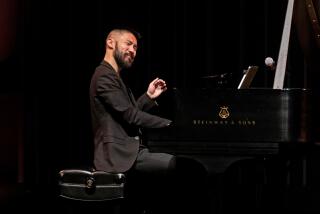Review: ‘Reinventing Bach’ by Paul Elie casts a wide net
Reinventing Bach
Paul Elie
Farrar, Straus and Giroux, 498 pp., $30.00
Halfway through reading Paul Elie’s “Reinventing Bach,” I suddenly got dizzy. An earthquake? All-purpose angst? Or could it be that Bach was working as an agent of transcendence on me as he did on this sincere author?
The basic pillars of this study are sturdy. Elie looks at how a composer influenced the outer and inner lives of four key 20th century Bachians — Albert Schweitzer, Pablo Casals, Leopold Stokowski and Glenn Gould — and how they then not only contributed to making Bach central to the modern musical experience but also radicalized it.
Elie doesn’t stop there. He weaves Bach’s biography into theirs. And into that he further weaves his own fervent reactions. He excitedly traipses through central Germany following Bach’s footsteps. And he sets this all against a century of vertiginous world events and pop culture and the advent of recording. Who wouldn’t get a little woozy?
Elie begins by taking us into the church in London where in 1935 Schweitzer — the French organist, theologian and famed medical missionary in Africa — recorded the Toccata and Fugue in D Minor. He shows Schweitzer to be a complicated and compromised revivalist, a doer of good deeds but with old-fashioned, colonialist values. To listen to Schweitzer is to step back in history, his Bach being a representation of all that was once good about civilization.
Around the same time Schweitzer recorded the D Minor Toccata and Fugue, Casals made his classic recording of Bach’s six solo cello suites. The Spanish cellist had discovered a copy of these forgotten masterpieces as a teenager in Barcelona and gave their first public performance 12 years later.
These old 78s are not a scratchy, churchy spiritual exercise but for Elie something new in music. The up-close studio sound is much closer to the here and now, which Elie describes as the aural equivalent of sculpture. This then means that listening has become a solitary not social pursuit, and that by playing the music over, a lay listener can “enter into the experience of the musician.”
In fact, any musician knows a virtual experience is just that. But it is true that Bach’s keyboard works have an extreme intimacy. Bach intended them for just a pupil or two sitting next to him at the keyboard.
Elie’s prose is flamboyant. Casals’ “animal sound all furred and tendoned” is likened to “a dinosaur’s cry.” Casals is “the mystic in the interior castle, the poet-pilgrim in a dark wood.” He is “spelunker, cave crawling the dark.” The sarabande of the Fifth Suite is “more a Kandinsky than a Picasso.”
It was only a few years after Schweitzer’s and Casals’ recordings that Stokowski relocated Bach’s Toccata and Fugue in D Minor into popular culture through Walt Disney’s “Fantasia.” But by calling the film the “one work of his that is unquestionably a classic,” Elie underestimates not only Stokowski’s brilliance as an arranger but his broad influence on musical culture.
The Bach cornucopia becomes maze-like in the post-World War II years. He finds a new breath of fresh Bachian air with a new generation of North American performers who were not dependent on European examples. And Gould gets the most credit for changing the course of Bach discussions with his electrifying yet structurally illuminating pianism and eccentric personality.
But Elie also represents a revolutionary Bach renaissance as part of the ‘50s cultural, scientific and technological explosion. The big picture includes the discovery of DNA, which might be a model for thinking about Bach’s intricate strands of counterpoint, the media theories of Marshall McLuhan (and, like Gould, a Torontonian) and most of all the advances in recording which allow for a much wider distribution of all kinds of music and a huge broadening of popular tastes.
By the end of the book, it’s a big Bach party, with room for all. Yo-Yo Ma, Steve Jobs, Lorraine Hunt Lieberson are there. Israel produces three Bachian Beatles — Itzhak Perlman is the cute one; Pinchas Zukerman, the quiet one; Daniel Barenboim, a Lennon-like intellectual. The real Beatles helped themselves to Bach as well. The composer reverberated through the halls of Abbey Road.
With digital downloads, we have shareable Bach, allowing the composer to enter into our cultural bloodstream like never before.
But Elie misses an even bigger picture. Bach had been in our bloodstream all along. The more significant Bach reinventions have been more musical than cultural or technological. They began with Mozart’s application of Bach’s harmonic and contrapuntal procedures. Beethoven’s visionary late style further absorbed Bach, as did Bartók’s in his groundbreaking string quartets. Mahler made his own versions of Bach’s orchestral suites.
Besides such musicians as Schweitzer and Casals making their case for Bach in the 1930s were the composers who were really reinventing Bach at the time. Neo-Classical Stravinsky and Hindemith — and, later in Brazil, Villa-Lobos — were Bach-infested. Like Stravinsky, Schoenberg arranged Bach for orchestra and so did Webern. Berg quoted Bach in his Violin Concerto.
The West Coast also gets too little attention for its role in a different kind of Bachian revolution, namely a revolt that had a huge effect on contemporary music. For Elie, the West is primarily about Walt Disney and the movies. But it was in California that Lou Harrison and Harry Partch went back to earlier tunings, discarded by Bach, and created new ones. John Cage and Terry Riley both mutinied against too much Bach — Cage in Schoenberg’s classes at UCLA, Riley at UC Berkeley. Among the results were the application of indeterminacy in art and the development of Minimalism in music.
In his quest for Bach, Elie casts his net widely, seeking from this one composer both spiritual transcendence and a connection with secular society and culture. He accuses Leonard Bernstein, for instance, of being out of touch for complaining in the 1950s that Bach’s music was still too much relegated to the church.
But no net catches it all, and a lot of music, especially in North America, was no longer going Bach’s way. Morton Feldman, a robust New York Jew and America’s most ethereally transcendent avant-garde composer added his voice (and pronounced accent) to Bernstein’s when he quipped: “So if I wanna hear a Brandenboig Concerto, I’ve gotta convoit?”
Transcendence is entirely a personal matter, and “Reinventing Bach” is one musical layman’s approach to an enormous subject.
More to Read
Sign up for our Book Club newsletter
Get the latest news, events and more from the Los Angeles Times Book Club, and help us get L.A. reading and talking.
You may occasionally receive promotional content from the Los Angeles Times.







